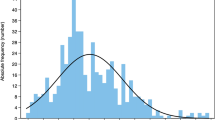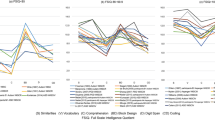Abstract
Youth with visual impairments often show difficulties with gross motor skills regardless of age or sex. Gross motor skills support positive developmental trajectories for health warranting the need for assessment. The Total Body Developmental Sequences (TBDS) are fast, easy-to-use, indices of gross motor development with relatively unknown psychometric properties for youth with visual impairments. The primary purpose of this study was to assess the psychometric properties of the TBDS with a secondary purpose to evaluate differential effects of biological sex, age, and degree of vision on gross motor skills. Youth with visual impairments (N = 57, ages 9 – 19 years, Boys = 23, Girls = 34) completed the TBDS and the Test of Gross Motor Development (TGMD-3). Results showed good initial psychometric properties (r = .89, α = .84, p < .001). Furthermore, the participants in this sample showed significant differences in gross motor skills based upon degree of vision (p < .05) but not sex or age (p > .05). The TBDS may now be used as an initial gross motor screening tool for youth with visual impairments. This initial screen (TBDS) is warranted as youth with visual impairments may show arrested development which may be exacerbated with more severe visual impairments.
Similar content being viewed by others
References
Bandalos, D. L. (2018). Measurement theory and applications for the social sciences. New York: Guildford Press.
Barnett, L. M., van Beurden, E., Morgan, P. J., Brooks, L. O., & Beard, J. R. (2010). Gender differences in motor skill proficiency from childhood to adolescence: A longitudinal study. Research Quarterly for Exercise and Sport, 81(2), 162–170.
Brian, A. (2020). Gross motor skill development of youth with visual impairments. In Haegele (Eds.), Movement and visual impairment: Research across disciplines. Philadelphia: Routledge
Brian, A., Goodway, J. D., Logan, J., & Sutherland, S. (2017). SKIPing with Head Start teachers: Influence of T-SKIP on object control skills. Research Quarterly for Exercise and Sport, 88(4), 479–491.
Brian, A., Taunton, S., Lieberman, L. J., Haibach-Beach, P., Foley, J., & Santarossa, S. (2018). Psychometric properties of the Test of Gross Motor Development-3 for children with visual impairments. Adapted Physical Activity Quarterly, 35(2), 145–158.
Brian, A., De Meester, A., Klavina, A., Irwin, J. M., Taunton, S., Pennell, A., & Lieberman, L. J. (2019a). Exploring children with visual impairments’ physical literacy: A preliminary investigation of autonomous motivation. Journal of Teaching in Physical Education, 38(2), 155–161.
Brian, A., Pennell, A., Haibach-Beach, P. S., Foley, J., Taunton, S., & Lieberman, L. J. (2019b). Correlates of physical activity among children with visual impairments. Disability and Health Journal, 12(2), 328–333.
Brian, A., Pennell, A., Taunton, S., Starrett, A., Howard-Shaughnessy, C., Goodway, J. D., et al. (2019c). Motor competence levels and developmental delay in early childhood: A multicenter and cross-sectional study conducted in the USA. Sports Medicine, 49(10), 1609–1618.
Brian, A., Getchell, N., True, L., De Meester, A., & Stodden, D. (2020a). Reconceptualizing and operationalizing Seefeldt’s proficiency barrier: Applications, and future directions. Sports Medicine, advance online publication. https://doi.org/10.1007/s40279-020-01332-6.
Brian, A., Starrett, A., Pennell, A., Beach, P., Gilbert, E., Stribing, A., Taunton Miedema, S., & Lieberman, L. J. (2020b). Longitudinal locomotor competence and BMI across sex and vision level for youth with visual impairments: A three-year investigation. Adapted Physical Activity Quarterly.
Burton, A. W., & Miller, D. E. (1998). Movement skill assessment. Human Kinetics.
DinanThompson, M., & Penney, D. (2015). Assessment literacy in primary physical education. European Physical Education Review, 21(4), 485–503.
Georgakis, S., Wilson, R., & Evans, J. (2015). Authentic assessment in physical education: A Case study of game sense pedagogy. The Physical Educator, 72(1), 67–86.
Goodway, J. D., Ozmun, J. C., & Gallahue, D. L. (2019). Understanding motor development: Infants, children, adolescents, adults. Jones & Bartlett.
Haegele, J. A., & Porretta, D. (2015). Physical activity and school-age individuals with visual impairments: A literature review. Adapted Physical Activity Quarterly, 32(1), 68–82.
Haegele, J. A., Brian, A., & Goodway, J. D. (2015). Fundamental motor skills and school-aged individuals with visual impairments: A review and directions for future research. Review Journal of Autism and Developmental Disorders, 2(3), 320–327.
Haegele, J. A., Aigner, C., & Healy, S. (2019). Physical activity, body mass index, and health status among youth with severe visual impairments aged 13–17 years in the United States. Disability & Health Journal, 12(1), 24–28.
Haegele, J. A., Hodge, S. R., Zhu, X., Holland, S. K., & Wilson, W. J. (2020). Understanding the inclusiveness of integrated physical education from the perspectives of adults with visual impairments. Adapted Physical Activity Quarterly, 37(2), 141–159.
Haibach, P. S., Lieberman, L., & Pritchett, J. (2011). Balance in adolescents with and without visual impairments. Insight Journal, 4(3), 112–123.
Haibach, P. S., Wagner, M. O., & Lieberman, L. J. (2014). Determinants of gross motor skill performance in children with visual impairments. Research in Developmental Disabilities, 35, 2577–2584.
Haywood, K., & Getchell, N. (2019). Life span motor development (7th ed.). Champaign: Human Kinetics.
Houwen, S., Visscher, C., Hartman, E., & Lemmink, K. A. P. M. (2007). Gross motor skills and sports participation of children with visual impairments. Research Quarterly for Exercise and Sport, 78(2), 16–23.
Houwen, S., Visscher, C., Lemmink, K. A. P. M., & Hartman, E. (2008). Motor skill performance of school-age children with visual impairments. Developmental Medicine and Child Neurology, 50(2), 139–145.
Houwen, S., Hartman, E., Jonker, L., & Visscher, C. (2010). Reliability and validity of the TGMD-2 in primary-school-age children with visual impairments. Adapted Physical Activity Quarterly, 27(2), 143–159.
Kirk, M. A., & Rhodes, R. E. (2011). Motor skill interventions to improve fundamental movement skills of preschoolers with developmental delay. Adapted Physical Activity Quarterly, 28(3), 210–232.
Kozub, F. M., & Oh, H. (2004). An exploratory study of physical activity levels in children and adolescents with visual impairments. Clinical Kinesiology, 58(3), 1–7.
Lander, N. J., Hanna, L., Brown, H., Telford, A., Morgan, P. J., Salmon, J., & Barnett, L. M. (2017). Physical education teachers’ perspectives and experiences when teaching FMS to early adolescent girls. Journal of Teaching in Physical Education, 36(1), 113–118.
Leirhaug, P. E., & MacPhail, A. (2015). ‘It’s the other assessment that is the key’: three Norwegian physical education teachers’ engagement (or not) with assessment for learning. Sport, Education and Society, 20(5), 624–640. https://doi.org/10.1080/13573322.2014.975113
Lieberman, L. J., Houston-Wilson, C., & Kozub, F. (2002). Perceived barriers to including students with visual impairments and blindness into physical education. Adapted Physical Activity Quarterly., 19(3), 364–377.
Lieberman, L. J., Haibach, P. S., & Wagner, M. O. (2014). Let’s play together: Sports equipment for children with and without visual impairments. Palaestra, 28(2), 13–15.
Linsenbigler, K., Petersen, S., & Lieberman, L. (2018). Barriers to physical activity for children with visual impairments: How far have we come and where do we still need to go? Palaestra, 32(1), 26–31.
National Physical Activity Plan Alliance. (2018). The 2018 United States report card on physical activity for children and youth. Washington, DC: National Physical Activity Plan Alliance.
Palmer, K., & Brian, A. (2016). Test of Gross Motor Development-2 scores differ between expert and novice coders. Journal of Motor Learning and Development, 4(2), 142–151.
Seefeldt, V. (1980). Developmental motor patterns: Implications for elementary school physical education. In C. Nadeau, W. Holliwell, K. Newell, & G. Roberts (Eds.), Psychology of motor behavior and sport (pp. 314–323). Champaign: Human Kinetics.
Seefeldt, V., & Haubenstricker, J. (1976). Developmental sequences of fundamental motor skills. Michigan State University: Unpublished research.
Seefeldt, V., & Haubenstricker, J. (1978). Competitive athletics for children-the Michigan study. Journal of Physical Education and Recreation, 49(3), 38–41.
Seefeldt, V., & Haubenstricker, J. (1982). Patterns, phases, or stages: An analytical model for the study of developmental movement. In J. A. S. Kelso & J. E. Clark (Eds.), The Development of Movement Control and Co-ordination (pp. 309–318). Wiley.
Stodden, D. F., Goodway, J. D., Langendorfer, S. J., Roberton, M. A., Rudisill, M. E., Garcia, C., & Garcia, L. E. (2008). A developmental perspective on the role of motor skill competence in physical activity: An emergent relationship. Quest, 60, 290–306.
Tamplain, P., Webster, E.K., Brian, A., & Valentini, N.C. (2019). Assessment of motor development in childhood: Contemporary issues, considerations, and future directions. Journal of Motor Learning and Development. https://doi.org/10.1123/jmld.2018-0028
Ulrich, D. A. (2000). Test of gross motor development (2nd ed.). Austin: Pro-Ed.
Ulrich, D. A. (2017). Introduction to the special section: Evaluation of the psychometric properties of the TGMD-3. Journal of Motor Learning and Development, 5(1), 1–4.
Ulrich, D. A. (2019). Test of gross motor development (3rd ed.). Austin: Pro-Ed Inc.
Webster, E. K., & Ulrich, D. A. (2017). Evaluation of the psychometric properties of the Test of Gross Motor Development—third edition. Journal of Motor Learning and Development, 5(1), 45–58.
Weil, E., Wachterman, M., McCarthy, E. P., Davis, R. B., O'Day, B., Iezzoni, L. I., & Wee, C. C. (2002). Obesity among adults with disabling conditions. Journal of the American Medical Association, 288(10), 1265–1268.
Funding
This project received funding from a University of South Carolina ASPIRE I Grant.
Author information
Authors and Affiliations
Contributions
Brian and Fisher are co-lead authors with equal contributions.
Corresponding author
Ethics declarations
Conflict of Interest
No conflicts of interest.
Ethics Approval
The University of South Carolina Institutional Review Board and with the 1964 Helsinki declaration approved all procedures.
Informed Consent
Parents provided written consent and children verbal assent for participation.
Consent for Publication
This manuscript is not submitted anywhere else nor has it been published elsewhere.
Additional information
Ali Brian and Jenna R. Fisher denotes co-lead authorship
Rights and permissions
About this article
Cite this article
Brian, A., Fisher, J.R., Miedema, S.T. et al. The initial psychometric properties for the Total Body Developmental Sequences for youth with visual impairments. J Dev Phys Disabil 33, 725–740 (2021). https://doi.org/10.1007/s10882-020-09769-3
Accepted:
Published:
Issue Date:
DOI: https://doi.org/10.1007/s10882-020-09769-3




